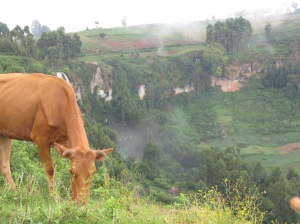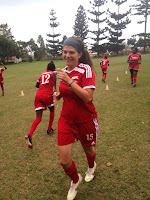Many USP students keep their own blogs during their
semester in Uganda. Besides being a way to easily update friends and
family on events going on, these blogs often provide space to share thought
processes and insights gained from their experiences.
Today we are featuring a blog post from one of our Fall 2015 homestay students, Kendra Pankow (Lawrence University). In this post, Kendra weaves
together concepts she’s learned in class with her own observations from her
rural homestay in Kapchorwa. Thanks Kendra for sharing!
WHAT IS COMMUNITY?
What does it mean to be a part of a community? What does it mean to live a life dedicated to knowing God’s family? According to Nouwen, McNeill, and Morrison, “the togetherness of the Christian community…is not the result of shared anger or anxiety; it grows from a deep sense of being called together to make God’s compassion visible in the concreteness of everyday living” (74).
I have often thought about what community looks like because the idea of a true community is very appealing to me. The idea of being with people, always having a group to belong to, and having people to care for and take care of you seems like something that everyone should be a part of. However, what does this actually look like? What does it mean to make God’s compassion visible in the ‘concreteness of everyday living’? The book Compassion discusses how to sit with people in their hurt. The authors discuss how individuals can be together with people in their real hardships in order to show compassion. We talked in class about how one must know how to sit with each other in the day-to-day life activities in order to be able to show this compassion most successfully.
John Taylor talks about presence in his work Primal Vision. He suggests that many Africans have a better sense of knowing how to simply ‘be’ than most westerners. Instead of always being focused on the next item on the agenda or where they would rather be, Africans are able to sit in the moment and enjoy the surroundings and people. The idea of not scheduling everything, not always thinking ahead, and not worrying about how to be as productive as possible is again appealing to me. Both John Taylor and the authors of Compassion have brought to my attention a possible sense of community that is possibly attainable; however, the remaining question is ‘how’. How can I practically find this type of community where everyone is present with each other and are able to express true compassion?
Although there is a great sense of community where I usually live, it sometimes gets blurred in my mind because of school and my everyday living. But I finally caught a deeper glimpse of this type of lifestyle in Kapchorwa! I finally saw in detail a community that could ‘be’ together. I finally saw a community that lived life together – sitting with each other in pain, celebration, and everyday life. Unlike many western neighborhoods where streets are quiet because kids are inside playing with their electronics, kids in the area of Kapchorwa where I lived were together as much as possible! I lived in their designated ‘hang-out’ compound. If at any point they were free of chores and schoolwork, they would come to our compound to see if any kids were free to play. The kids already knew a sense of community and belonging that many western adults do not know. They asserted themselves enough to simply come to the group instead of waiting to be invited, and all were welcomed – two concepts that I think are necessary for this kind of community.
It was not only the kids living in community together. The adults lived life in community as well. Neighbors, family members, and distant relations were constantly checking in on each other.
In a matter of one day, we might have had three to five visitors to our compound that wanted nothing more than to check to make sure we were doing all right. We were still living, functioning, and doing well. My mother was actually asked why she had not been to check in on someone recently; it is an EXPECTATION on community members to visit people! I am learning that the idea of checking-in on people plays a huge role in creating a community that knows how to sit with each other. Without checking in on each other, they would not know when someone was hurting, or when someone was celebrating. They would also not have built a deep enough relationship in which individuals can jump into each others’ lives through help or encouragement.
 |
| A view of church |
In this Kapchorwa community, members also knew how to appreciate each other. People were constantly thanking each other and appreciating them for the work they were doing, even if the work they were doing in no way affected the one doing the thanking. Members of the community were thanked simply for harvesting their crops, or doing their dishes. The sense of appreciation, encouragement, and being with people enough to appreciate the work they are doing for themselves, I think plays a huge role in creating this type of community that we have discussed in class.
It was wonderful to finally see a functioning community that knows how to sit with each other and simply ‘be’. Sometimes it is easy to get caught up in theoretical thoughts when we only discuss ideas from books in class, but being in Kapchorwa gave me a view into what a community could actually look like: a kind of community I would like to be a part of.
 |
| My current community on top of a mountain! |




















